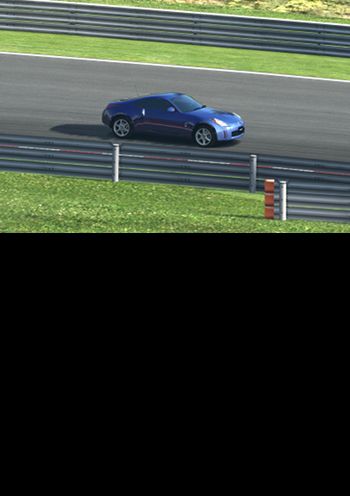Made by the same team that had previously created the "Test Drive" series for platforms such as the Amiga, The Need for Speed saw you driving exotic sports cars against the clock or a single AI opponent on public freeways, darting in and out of traffic in order to record the best time possible. The original 3DO version put its focus on realism above all else, with digitized car cockpits, fully recorded engine sounds, and a positively wonderful physics engine that stands up well even today-- which is especially impressive considering it was written to run on the 3DO's main RISC CPU, which was only clocked at 13 MHz.
They teamed with famous car magazine "Road & Track" to provide audio and video commentary for each of the game's eight cars, in addition to detailed in-game spec sheets and photo galleries.
For the DOS, Saturn, and PSX ports, the development team essentially re-wrote the physics engine, turning the game into more of an arcade experience-- essentially "dumbing down" the title for the more mainstream audiences on the aforementioned platforms. Unfortunately, it was this arcade influence that became the staple for the rest of the series.
As it stands, The Need for Speed is essentially a 3DO exclusive, since the ports played nothing like it. And there still hasn't been another video game that captures the actual act of driving as well as this game.
But is that really true? Does the game still stack up? To find out, I decided to pit it against the most realistic console-based sim racer currenty on the market: Gran Turismo 5.
For all of Polyphony's bragging about Gran Turismo 5's massive car library-- which I might add is padded by the gazillion MX-5 and Civic variations among others-- the title lacked direct equivalents for most of The Need for Speed's cars. To compensate, I took the closest car that I could find, then adjusted them to achieve the same power-to-weight ratio as their The Need for Speed counterparts. Below is a table of those adjustments.
And because I've always been curious as to whether my real-life daily driver-- a 2003 Nissan 350z Touring-- would be competitive in The Need for Speed, I included that car in all of the Gran Turismo 5 tests.
The Need for Speed car | Gran Turismo 5 equivalent | Adjustments required | PP after adjustment |
1994 Acura NSX | 1997 Acura NSX | Dropped power to 268 bhp to achieve same power-to-weight ratio | 437 |
1994 Chevrolet Corvette ZR1 | 1990 Chevrolet Corvette ZR1 | Got same power-to-weight ratio: 397 bhp, 3174 lbs | 492 |
1994 Dodge Viper RT/10 | 2002 Dodge Viper GTS | Got same power-to-weight ratio, 379 bhp, 3112 lbs | 503 |
1994 Ferrari 512TR | 1976 Ferrari 512BB | Got same power-to-weight ratio, 375 bhp, 2839 lbs | 496 |
1994 Lamborghini Diablo VT | 1974 Lamborghini Countach LP400 | Got same power-to-weight ratio, 365 bhp, 2686 lbs | 491 |
1994 Mazda RX-7 | 1993 Mazda RX-7 Type RZ | Do nothing, identical | 432 |
2003 Nissan 350z Touring | 2003 Nissan 350z | Do nothing, identical | 455 |
1994 Porsche 911 Carrera | 1986 RUF BTR | Got same power-to-weight ratio, 232 bhp, 2601 lbs | 436 |
1994 Toyota Supra RZ | 1997 Toyota Supra RZ | Increase weight to 1655 kg | 463 |
I then raced all eight cars-- plus my 350z in Gran Turismo 5-- around each of the six tracks and routes, recording their times and percentages behind the leader in each case. Below is the outcome.
Car | High Speed Ring (GT5) | HSR Versus Leader (GT5) | City (NFS) | City Versus Leader (NFS) |
NSX | 01:22.97 | 5.97% | 11:20.50 | 10.99% |
Corvette ZR1 | 01:20.90 | 3.33% | 10:32.50 | 3.16% |
Viper RT/10 | 01:19.61 | 1.68% | 10:34.50 | 3.49% |
512TR | 01:18.29 | 0.00% | 10:13.10 | 0.00% |
Diablo VT | 01:18.34 | 0.06% | 10:31.70 | 3.03% |
RX-7 | 01:24.43 | 7.84% | 11:27.50 | 12.14% |
350z Touring | 01:21.84 | 4.53% | N/A | N/A |
911 Carrera | 01:23.39 | 6.51% | 10:39.00 | 4.22% |
Supra RZ | 01:23.59 | 6.77% | 10:51.50 | 6.26% |
Car | Grand Valley Speedway (GT5) | GVS Versus Leader (GT5) | Coastal (NFS) | Coastal Versus Leader (NFS) |
NSX | 02:23.25 | 4.78% | 12:11.30 | 4.00% |
Corvette ZR1 | 02:21.71 | 3.65% | 11:43.20 | 3.14% |
Viper RT/10 | 02:18.68 | 1.44% | 12:01.70 | 5.85% |
512TR | 02:17.58 | 0.63% | 11:21.80 | 0.00% |
Diablo VT | 02:16.72 | 0.00% | 12:07.90 | 6.76% |
RX-7 | 02:25.28 | 6.27% | 12:41.80 | 11.73% |
350z Touring | 02:19.14 | 1.77% | N/A | N/A |
911 Carrera | 02:22.48 | 4.21% | 11:39.60 | 2.61% |
Supra RZ | 02:22.86 | 4.49% | 11:51.10 | 4.30% |
Car | Tsukuba (GT5) | Tsukuba (GT5) | Alpine (NFS) | Alpine Versus Leader (NFS) |
NSX | 01:09.24 | 4.75% | 15:06.60 | 5.71% |
Corvette ZR1 | 01:09.01 | 4.39% | 14:42.50 | 2.90% |
Viper RT/10 | 01:06.10 | 0.00% | 14:45.70 | 3.28% |
512TR | 01:06.39 | 0.44% | 14:17.60 | 0.00% |
Diablo VT | 01:06.21 | 0.16% | 14:45.80 | 3.29% |
RX-7 | 01:10.21 | 6.22% | 15:25.90 | 7.96% |
350z Touring | 01:07.44 | 2.03% | N/A | N/A |
911 Carrera | 01:09.05 | 4.47% | 14:49.20 | 3.68% |
Supra RZ | 01:08.99 | 4.37% | 14:42.70 | 2.93% |
Car | Gran Turismo 5 impressions | The Need for Speed impressions |
NSX | Rotates nicely, great balance | Handles like a dream, very easy to squeeze through traffic |
Corvette ZR1 | Feels a lot more front-heavy than the NSX, has a tough time putting power down | Nice compromise between handling and power, feels a little too front-heavy though |
Viper RT/10 | Understeers as much as the Corvette, but feels like more engineered car | Tough to not run into things with this car, good power but needs traction control |
512TR | Even better balanced than the NSX | Best car in the game by a wide margin; super fast, and handles superbly as well |
Diablo VT | Not nearly as balanced as the Ferrari, feels a bit quicker though | A better Viper, but could really use some traction control as well |
RX-7 | Not as balanced as NSX, but downy-light and fun to drive | Fun to whip through corners, tail-happy, but severely underpowered |
350z Touring | Feels front heavy but amazingly balanced, a real corner carver | N/A |
911 Carrera | Huge amounts of oversteer; takes concentration, but very pleasing to drive | Handles wonderfully, but too bad the 993 Turbo didn't come out until 1995 |
Supra RZ | Not enough weight over the rear tires, but feels reasonably balanced | Grippy but not balanced, feels like less than the sum of its parts |
- Both games have outstanding physics engines, but focus on different things
- Gran Turismo 5 does a great job of communicating a car's balance; oversteer and understeer come on very naturally, each car's personality really comes through. On the negative side, the cars feel too light and floaty. Turn 10's "Forza Motorsport" series suffers from that problem as well
- In The Need for Speed, cars feel super weighty as if you're wrestling with them. Feels more like "real driving", go to Youtube and watch videos of people racing real cars at the limit, NFS captures that "reverse lock" sensation excellently. On the negative side, the all-important aspect of balance isn't as well represented as it is in GT5
-
In Gran Turismo 5 power rules the day. In The Need for Speed, traction control is more important
- Outside of the City course, The Need for Speed punishes cars without traction control to an extreme level. Notice how closely correlated the times are between the two games on the City course versus the latter two tracks/courses, which are much twistier
- The cars without traction control, such as the Viper and Diablo, really struggle in NFS versus GT5. Again, that statement doesn't hold true on City, which is largely straight-aways
- In Gran Turismo 5, traction control is globally either on or off, regardless of each car's capabilities in real life. I left it on the entire time. To get a clearer picture, it would be interesting to disable traction control in GT5 before racing the cars that didn't have it in real life. Ditto for ABS
-
Upon close inspection, some of the car specs are slightly off in The Need for Speed
- For example, according to Wikipedia the 1994 Supra RZ had a curb weight of 3417 lbs
- In The Need for Speed, its curb weight is liste as 3600 lbs
- This discrepancy seems to unfairly punish the car's handling predictability in NFS, and could be skewing scores a bit if there are very many other spec inconsistencies
-
My 350z would not be out of place at all in The Need for Speed
- Amazingly, the 350z was the fourth-best car in Gran Turismo 5 averaged across the three tracks, just behind the "big guns": the Diablo, Testarossa, and Viper
- It has traction control, which is all-important in The Need for Speed; recipe for success!
-
Both games agree: the RX-7 is completely outclassed in this crop of cars despite having a competitive PP value in GT5
- Amazingly, was the slowest car across all six tracks and courses
- Fun to drive in both games, but feels extremely underpowered
- Conversely, had the 993 Turbo been out when this game was made and been included in lieu of the Carrera, the 911 would probably have been the best car in NFS-- on a per-BHP basis the Carrera gets some impressive times in Coastal and Alpine, and added power would have made it competitive in City as well
Conclusion
So there you have it! The Need for Speed stacks up exceptionally well. It manages to be both realistic and "gamey" at the same time, without sacrificing anything in either department. As a game, there's no doubt it's more fun to play than the current console sim racer of choice-- Gran Turismo 5-- and it stacks up really well in the realism department even when compared to the aforementioned Polyphony title, which came out 18 years later, and on a much more powerful hardware platform as well.
To wrap up, here are screenshots I took of each car in the two games.
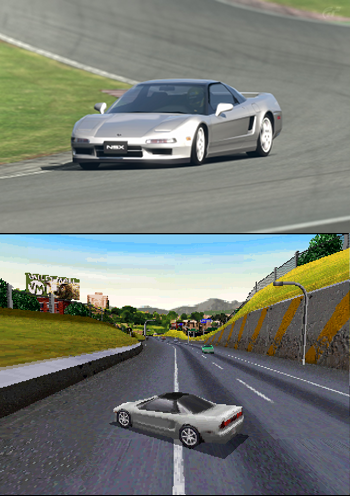
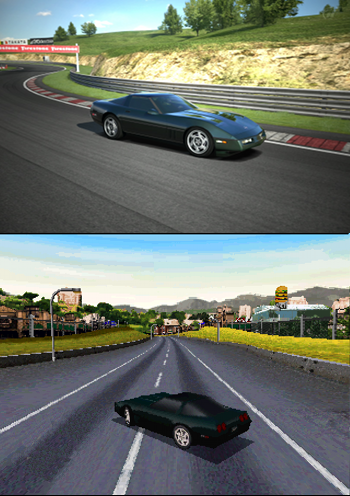
Dodge Viper and Ferrari 512BB/512TR
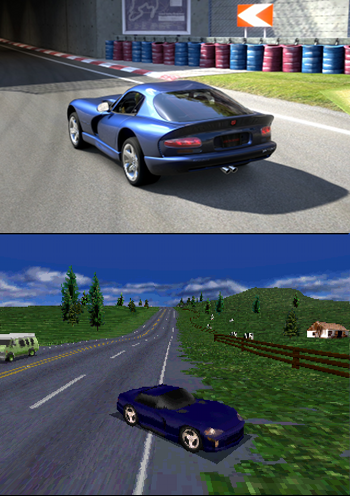

Lamborghini Countach/Diablo and Mazda RX-7
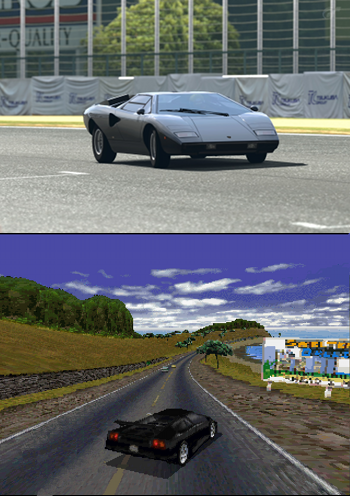
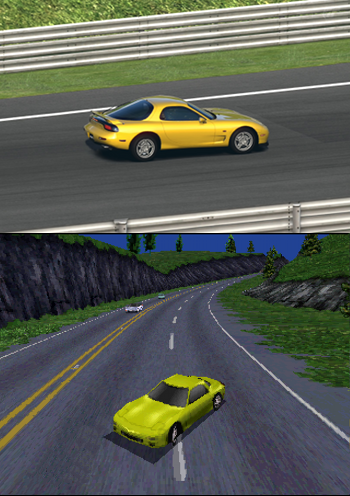
Porsche 911 and Toyota Supra
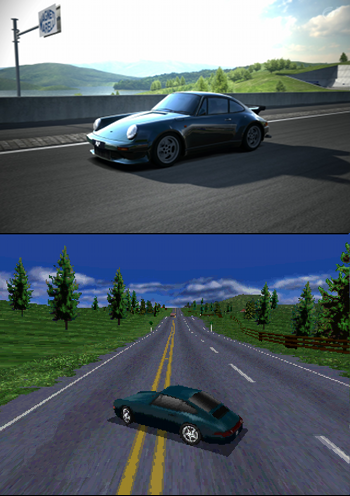
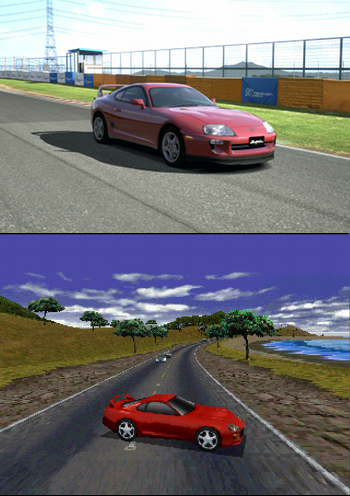
Nissan 350z
